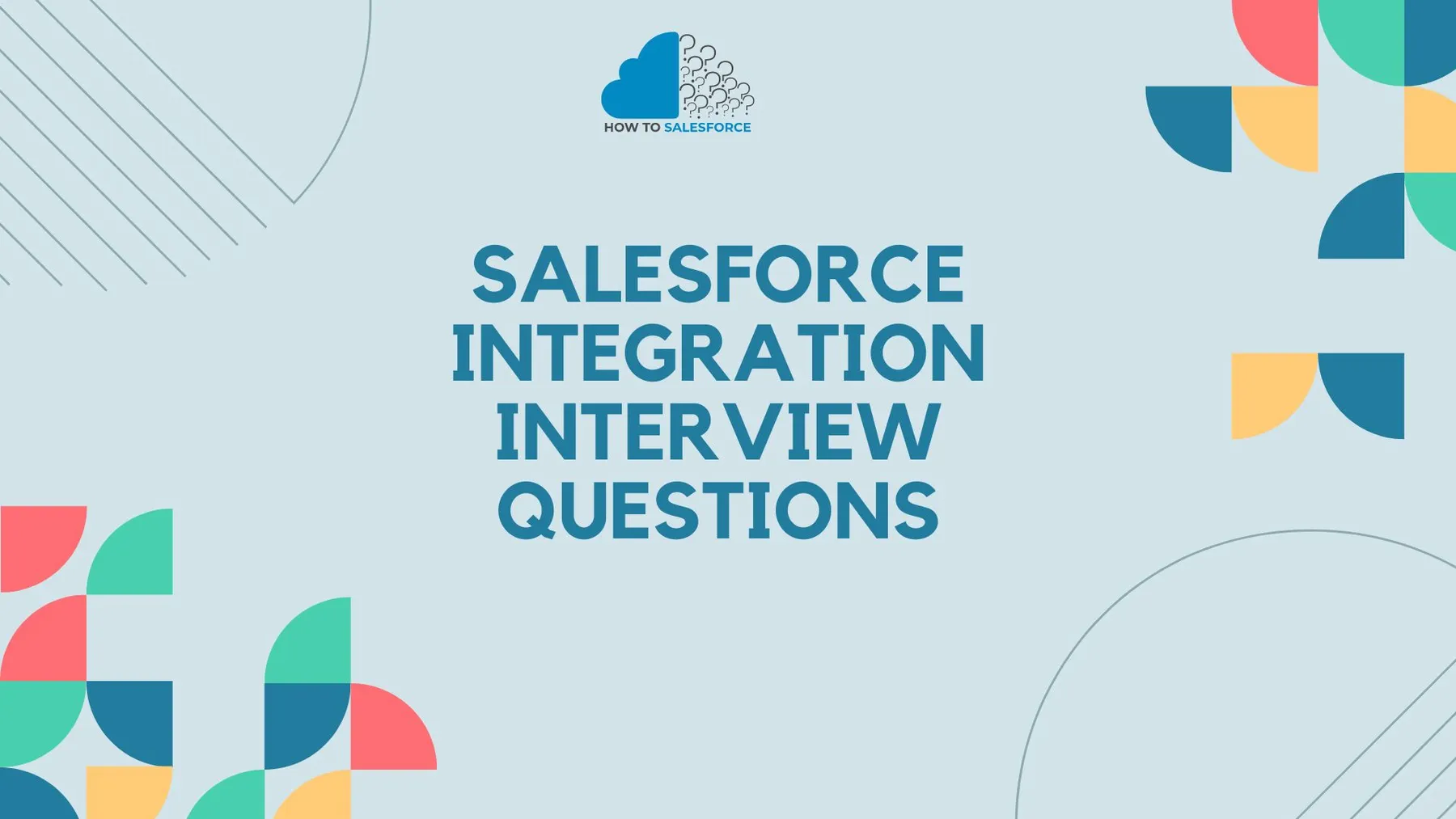Introduction
Salesforce integration is an important part of modern business processes because it makes it easier for Salesforce and other systems to talk to each other. You can be much more prepared for an interview in this field if you know the most important questions to ask.
To ensure you’re ready for success, this book provides a comprehensive analysis of the most frequently asked interview questions about Salesforce integration.
Read my other blog: Understanding SFDC Lightning
1. Comprehending Salesforce Integration
Salesforce integration means linking Salesforce to other databases, programs, or systems so that users can share data, speed up processes, and get more done. It’s a very important skill for coders, managers, and builders, and getting good at it will help you move up in your field.
1.1. What is Integration with Salesforce?
Salesforce integration means connecting Salesforce to other systems so that you can automate tasks and share data more easily. You can use a variety of tools and methods, such as software, APIs, and custom code, to accomplish this.
1.2. The Significance of Salesforce Integration
Integration is important because it helps businesses simplify their processes and make sure that data can flow easily between different systems. This leads to more work getting done, fewer mistakes made by hand, and a full knowledge of how the business works.
2. Salesforce Integration Types
Knowing how the different Salesforce connections work is important for answering interview questions correctly. There are different problems and goals with each type of merging.
2.1. Integration of Data
One part of data merging is keeping data in Salesforce and other systems in sync. This makes sure that info is always available when it’s needed and the same on all devices.
- Batch Data Integration: At predetermined intervals, data is sent in batches.
- Real-Time Data Integration: As soon as changes take place, data is transferred right away.
2.2. Integration of Procedures
Process integration connects Salesforce with other systems to automate business processes. This approach ensures that workflows across various platforms are optimized and efficient.
- Workflow Automation: Triggering procedures in other systems depending on actions in Salesforce.
- Business Process Management (BPM): Managing intricate procedures among several platforms.
2.3. Integration of User Interface
Users can talk to more than one system through a single window thanks to user interface interaction. Users can access more Salesforce services with this type of connection, which makes their experience better.
- Embedded Applications: Including outside apps in Salesforce’s user interface.
- Custom UIs: Developing unique user interfaces for Salesforce and other applications.
3. Frequently Asked Interview Questions for Salesforce Integration
It’s very important to be ready for possible interview questions if you want to do well. Here are some questions that people often ask about hiring for Salesforce integration, along with possible answers.
3.1. Which Salesforce API Types Are Available for Integration?
Salesforce provides several integration APIs, each with a distinct function:
- REST API: Applied to basic data models for lightweight integration.
- SOAP API: Fits well for more intricate integrations that need strong error management.
- Bulk API: Made to manage substantial data loads.
- Streaming API: Provides Salesforce with real-time data streaming.
- Metadata API: Used to manage customization information, such as custom objects and page layouts.
- Apex REST/SOAP API: Custom APIs established using Apex for unique needs.
3.2. How Do You Handle Data Synchronization Between Salesforce and External Systems?
There are various ways to manage data synchronization:
- Scheduled Batch Jobs: Consistently synchronizing data at predetermined intervals.
- Real-Time Integration: Using Salesforce’s Streaming API or Platform Events to update data instantaneously.
- Middleware Solutions: Employ middleware such as Dell Boomi or MuleSoft to handle intricate synchronization needs.
3.3. What Difficulties Might You Face During Salesforce Integration?
Many difficulties may come up during Salesforce integration:
- Data Mapping Issues: Make sure that Salesforce’s data fields correspond with those in the external system.
- API Limits: Staying within Salesforce’s API call limits to avoid exceeding thresholds;
- Security Concerns: Making sure that data transfer between systems is safe and compliant with laws.
- Performance: Optimizing integration so as not to affect system performance adversely.
3.4. How Do You Ensure Data Security During Salesforce Integration?
Data security is a top priority during integration. Techniques include:
- Encryption: Encrypting information while it’s in transit and at rest.
- OAuth: Securing API authentication with OAuth.
- Field-Level Security: Making certain that during integration, sensitive data fields are safeguarded.
- Frequent Audits: To detect and reduce threats, conduct security audits frequently.
4. Salesforce Integration Best Practices
Being aware of the best practices for integrating Salesforce will help you answer interview questions with assurance and prove your knowledge.
4.1. Whenever possible, use standard APIs
To make integration easier, take advantage of Salesforce’s standard APIs, such as REST and SOAP. Only extreme circumstances should warrant the use of custom APIs.
4.2. Employ Middleware for Complex Integrations
Middleware programs like MuleSoft can handle the complexities and offer a scalable solution for intricate interfaces involving several systems.
4.3. Enhance Calls to APIs
Minimize the number of API requests to keep under Salesforce’s restrictions and increase performance. Utilize batch operations and the Bulk API to efficiently handle large datasets.
4.4. Put Error Handling and Logging Into Practice
To promptly detect and address problems, make sure your integration has strong error handling and logging features.
4.5. Track Integration Effectiveness
Keep an eye on how well your integrations are working to make sure everything is running smoothly. You can use third-party tracking services or the tools that come with Salesforce.
5. Introductory Questions about Salesforce Integration
You can run into more complex questions in senior roles that require a better comprehension of Salesforce integration.
5.1. How Would You Manage Complicated Business Logic in an Integration with Salesforce?
When dealing with complicated business theory, contemplate the following approaches:
- Apex Triggers and Classes: Compose Apex code to manage intricate data transfer logic.
- Flow Builder: Automate complex operations without writing code by utilizing Salesforce’s Flow Builder.
- Custom Middleware Logic: To guarantee consistency across systems, implement business logic inside middleware.
5.2. How Does Salesforce Connect Operate, and What Does It Entail?
With Salesforce Connect, you can get to external data right away without having to save it in Salesforce. It uses OData (Open Data Protocol) to get data from other systems and shows it in Salesforce as if it were local data.
- Use Cases: Duplicate-free real-time data access.
- Restrictions: Situations requiring high performance or substantial data quantities may not suit Salesforce Connect.
5.3. How Would You Combine a Legacy System with Salesforce?
Because of old technology, it might be hard to connect Salesforce to older systems. One way to do it would be:
- APIs: REST or SOAP can be used for integration if the legacy system supports them.
- Middleware: To connect Salesforce and the old system, use middleware.
- Custom Adapters: Create unique adapters to convert data formats between different platforms.
5.4. In a Multi-Organization Salesforce Environment, How Do You Manage Integration?
Careful planning is needed to manage integration in a setting with more than one organization:
- Centralized Middleware: To manage integrations between many Salesforce organizations, use a centralized middleware solution.
- Data Governance: Put in place data governance guidelines to guarantee correctness and uniformity throughout organizations.
- API Gateway: To control and keep an eye on API traffic between organizations, use an API gateway.
6. Salesforce Integration Common Scenarios and Solutions
During your interview, you might encounter specific scenarios related to Salesforce integration. Here are a few instances along with possible responses.
6.1. Case Study: Connecting Salesforce to an Online Store
When asked how to combine Salesforce with a platform for online sales like Shopify or Magento:
- Approach: To connect to the e-commerce platform’s API, use Salesforce’s REST API. In real-time, sync customer information, orders, and inventories.
- Tools: If you need to handle particular business logic, think about utilizing custom Apex REST services or middleware like MuleSoft.
6.2. Lead Management Scenario: Real-Time Integration
For managing leads in real-time:
- Approach: As new leads are being captured on an external website, push them into Salesforce using the Streaming API or Platform Events.
- Points to Ponder: Before entering lead data into Salesforce, make sure it has been cleaned up and deduplicated.
6.3. Scenario: Data Migration During Salesforce Implementation
While moving information from an outdated CRM to Salesforce:
- Method: For massive data volumes, use the Bulk API. When necessary, employ data transformation techniques to precisely map data fields.
- Difficulties: Take care of duplicates, resolve problems with data quality, and make sure historical data is properly mapped to Salesforce objects.
7. Getting Ready for Your Interview on Salesforce Integration
You might do better if you study hard for your interview about Salesforce integration. Finally, here are some last tips that will help you do your best.
7.1. Examine Actual Integration Situations
Examine case studies and examples of Salesforce integration from the real world. Gaining an understanding of the implementation process for these integrations will help you respond to scenario-based questions with confidence.
7.2. Practical Application
If you can, try out Salesforce integration tools like MuleSoft, Dell Boomi, or custom Apex solutions for yourself. You need to have real-world knowledge, and it will boost your confidence during your interview.
7.3. Examine the Salesforce Records
The official documentation from Salesforce provides a wealth of information. Ensure that you are knowledgeable about the most recent features and integration best practices.
7.4. Mock Interviews
Consider performing practice interviews with a peer or mentor. By doing this, you can practice answering questions succinctly and clearly under time constraints.
8. Conclusion
It’s important to remember that the key to acing any interview is a solid understanding of the subject matter and the ability to apply that knowledge to real-world scenarios. Good luck with your preparation, and may you excel in your Salesforce integration interview!
Salesforce integration is a difficult but profitable area that needs a deep understanding of many tools, APIs, and best practices. By studying the most common interview questions and getting ready well, you’ll be ready to do well in your next interview.


